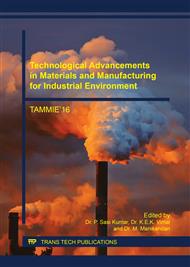[1]
Abolfazl Zahedi S, Murat Demiral, Anish Roy, Vadim V. Silberschmidt (2013), FE/SPH modelling of orthogonal micro-machining of f. c. c. single crystal, Computational Materials Science Vol. 78, pp.104-109.
DOI: 10.1016/j.commatsci.2013.05.022
Google Scholar
[2]
Alaa A. Olleak, Hassan A. El-Hofy (2015), SPH Modelling of Cutting Forces while Turning of Ti6Al4V Alloy, 10th European LS-DYNA Conference Vol. 33, No. 12, pp.753-763.
DOI: 10.1115/msec2015-9201
Google Scholar
[3]
C. Ezilarasan, V.S. Senthil kumar, A. Velayudham (2014), Theoretical predictions and experimental validations on machining the Nimonic C-263 super alloy, Internal Journal of Simulation Modelling Practice and Theory 40 Vol. 40, pp.192-207.
DOI: 10.1016/j.simpat.2013.09.008
Google Scholar
[4]
Fabian Spreng, Peter Eberhard (2015), Machining Process Simulations with Smoothed Particle Hydrodynamics, 15th CIRP Conference on Modelling of Machining Operations Vol. 31, pp.94-99.
DOI: 10.1016/j.procir.2015.03.073
Google Scholar
[5]
Jiwoo Nam, Taesung Kim, Seong Wook Cho (2014), A numerical cutting model for brittle materials using smooth particle hydrodynamics, Int J Adv Manuf Technol.
DOI: 10.1007/s00170-015-7223-y
Google Scholar
[6]
Johnson G.R., Cook W.H., 1983. A constitutive model and data for metals subjected to large strains, high strain rates and high temperatures, Proceed- ings of the 7th International Symposium on Ballistics, 547: 541-547.
Google Scholar
[7]
Jun Lin, Hakim Naceur, Daniel Coutellier, Abdel Laksimi (2013), Efficient mesh less SPH method for the numerical modelling of thick shell structures undergoing large deformations, International Journal of Non-Linear Mechanics.
DOI: 10.1016/j.ijnonlinmec.2014.04.009
Google Scholar
[8]
J. Limido, C. Espinosa, M. Salaun, J.L. Lacome (2011), Metal cutting modelling SPH approach, Vol. 9, Nos. 3/4, pp.177-196.
DOI: 10.1504/ijmmm.2011.039645
Google Scholar
[9]
A Mahamani (2014), Influence of Process Parameters on Cutting Force and Surface Roughness During Turning of AA2219-TiB2/ZrB2 In-situ Metal Matrix Composites, Internal Journal of Procedia Materials Science Vol. 6, pp.1178-1186.
DOI: 10.1016/j.mspro.2014.07.191
Google Scholar
[10]
Martin Madaja, Miroslav Píškaa (2013), On the SPH Orthogonal Cutting Simulation of A2024-T351 Alloy, 14th CIRP Conference on Modelling of Machining Operations (CIRP CMMO) Vol. 8, pp.152-157.
DOI: 10.1016/j.procir.2013.06.081
Google Scholar
[11]
Mohammad Ramezani, Ahmad Afsari (2015), Surface roughness and cutting force estimation in the CNC turning using artificial neural networks, Management Science Letters Vol. 5, pp.357-362.
DOI: 10.5267/j.msl.2015.2.010
Google Scholar
[12]
N.R. Rajasekaran, and V. Sampath (2011), Effect of In-Situ TiB2 Particle Addition on the Mechanical Properties of AA 2219 Al Alloy Composite, Journal of Minerals & Materials Characterization & Engineering Vol. 10, No. 6, pp.527-534.
DOI: 10.4236/jmmce.2011.106040
Google Scholar
[13]
N. Ruttimanna, M. Roethlina, S. Buhlb, K. Wegen era (2013), Simulation of Hexa-Octahedral Diamond Grain Cutting Tests Using the SPH Method, 14th CIRP Conference on Modeling of Machining Operations (CIRP CMMO) Vol. 8, pp.322-327.
DOI: 10.1016/j.procir.2013.06.110
Google Scholar
[14]
M. Takaffoli, M. Papini (2012), Numerical simulation of solid particle impacts on Al6061-T6 Part II: Materials removal mechanisms for impact of multiple angular particles, Wear 296 Vol. 296, pp.648-655.
DOI: 10.1016/j.wear.2012.07.022
Google Scholar
[15]
Uwe Heisel, Wiliam Zaloga, Dmitrii Krivoruchko, Michael Storchak, Liubov Goloborodko (2013), Modelling of orthogonal cutting processes with the method of smoothed particle hydrodynamics, Prod. Eng. Res. Devel. Vol. 7, pp.639-645.
DOI: 10.1007/s11740-013-0484-0
Google Scholar


